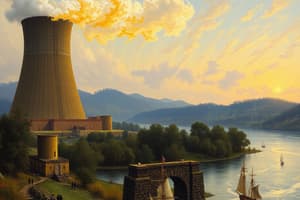Podcast
Questions and Answers
Match the following fossil fuels with their common usage in thermal power generation:
Match the following fossil fuels with their common usage in thermal power generation:
Coal = Primary fuel for generating electricity Natural Gas = Used for peaking power plants Oil = Backup fuel for emergencies Peat = Limited use due to environmental concerns
Match the following thermal power plant components with their functions:
Match the following thermal power plant components with their functions:
Boiler = Produces high-pressure steam Turbine = Converts steam energy into mechanical energy Condenser = Converts steam back to water Generator = Converts mechanical energy into electrical energy
Match the following renewable energy sources with their potential integration in thermal power plants:
Match the following renewable energy sources with their potential integration in thermal power plants:
Biomass = Co-firing with coal in boilers Solar Power = Supplementing energy during daylight hours Geothermal Energy = Using natural heat for steam production Hydropower = Providing backup power during low demand
Match the following environmental impacts with their association to thermal power plants:
Match the following environmental impacts with their association to thermal power plants:
Flashcards are hidden until you start studying
Study Notes
Fossil Fuels and Their Usage in Thermal Power Generation
- Coal: Widely used for electricity generation due to its abundance and low cost, but associated with high carbon emissions.
- Natural Gas: Increasingly popular because of its efficiency and lower emissions compared to coal, often used in gas-fired power plants.
- Oil: Primarily used in regions lacking other resources; less common due to higher emissions and cost compared to coal and gas.
Thermal Power Plant Components and Functions
- Boiler: Generates steam by heating water, using the combustion of fossil fuels or biomass.
- Turbine: Converts steam's thermal energy into mechanical energy, which drives the generator.
- Generator: Transforms mechanical energy from the turbine into electrical energy through electromagnetic induction.
- Condenser: Cools and condenses steam back into water, allowing it to be reused in the boiler.
Renewable Energy Sources and Their Integration in Thermal Power Plants
- Solar Energy: Can be integrated with thermal plants by using solar collectors to preheat water, enhancing overall efficiency.
- Biomass: Utilized as a renewable fuel in existing boilers to reduce reliance on fossil fuels and lower carbon emissions.
- Wind Energy: Potentially combined with thermal generation through hybrid systems, offering a stable power supply by complementing variable wind energy with thermal backup.
Environmental Impacts Associated with Thermal Power Plants
- Air Pollution: Emissions of sulfur dioxide, nitrogen oxides, and particulate matter contribute to smog and respiratory issues.
- Greenhouse Gas Emissions: Major contributor to climate change; thermal plants, especially those using coal, release significant CO2.
- Water Usage: Thermal plants require large amounts of water for cooling, impacting local water resources and aquatic ecosystems.
- Land Degradation: Mining for fossil fuels often leads to habitat destruction, erosion, and biodiversity loss.
Studying That Suits You
Use AI to generate personalized quizzes and flashcards to suit your learning preferences.




